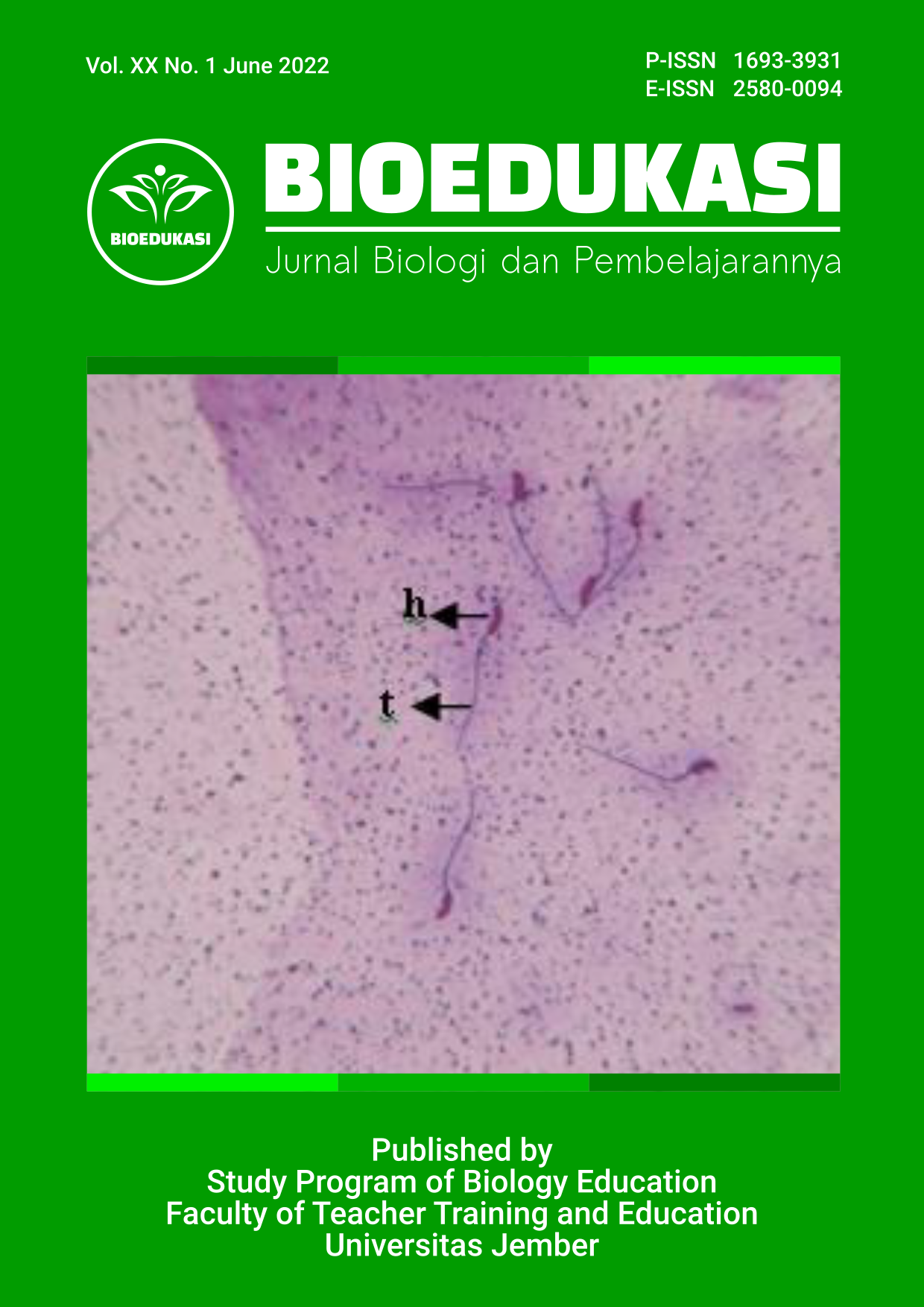EFFECT OF FEED COMPOSITION ON SPONSTIC PLASTIC WASTE DEGRADATION, SURVIVALITY AND LARVA GROWTH Tenebrio molitor L.
Abstract
Sponge plastic is one of the plastic wastes that is difficult to degrade. Recently research reported that Tenebrio molitor L larvae have the potential capability to degrade plastic waste. But still a lack information according to the effect of feed composition on survival, and growth of T. molitor L larvae. The purpose of this study was to determine the effect of plastic feed composition on the rate of degradation of sponge plastic waste, survival, and growth of T. molitor L larvae. The method used in this study was an experimental laboratory using Completely Randomized Design (CRD) and using controls and six treatments with 3 repetition times. The parameters measured in this study were survival (%), body length growth (cm/week) and body biomass (gram/week), and degradation rate (gram/week). The data obtained from the research results will be analyzed using ANOVA which is then tested by Duncan. The results showed that feed composition had a significant effect (p=0.001) on the rate of degradation of plastic sponge waste, survival (p=0.000), and growth (p=0.001) of T. molitor L larvae. degradation, survival, and growth of T. molitor L. larvae.
References
Hapsari, D. G. P. L., Fuah, A. M., & Endrawati, Y. C. (2018). Produktifitas Ulat Hongkong (T. molitor) pada Media Pakan yang Berbeda. Jurnal Ilmu Produksi dan Teknologi Hasil Peternakan, 6(2), 53-59
Hidayat, Yosi & Kiranamahsa, Saskia & Zamal, Muchammad. (2019). A study of plastic waste management effectiveness in Indonesia industries. AIMS Energy. 7. 350-370. 10.3934/energy.2019.3.350.
Lettieri, P., Al-Salem, S. (2011). Thermochemical treatment of plastic solid waste. In: Letcher TM,ValleroD, editors.Waste :A handbook for management;,p. 233–42.
Nukmal, N. 2018. Effect of styrofoam waste feeds on the growth, development and fecundity of mealworms (T. molitor). OnLine Journal of Biological Sciences, 18(1), 24-28.
Matyja, K., J. Rybak, B. Hanus-Lorenz, M. Wrobel, R. Rutkowski. 2020. Effects of Polystyrene Diet on T. molitor Larval Growth, Development and Survival: Dynamic Energy Budget (DEB) Model Analysis. Environmental Pollution. 264: 1-11.
Puls, J., Wilson, S.A. & Hölter, D. Degradation of Cellulose Acetate-Based Materials: A Review. J Polym Environ 19, 152–165 (2011). https://doi.org/10.1007/s10924-010-0258-0
Yang, S.-S., Brandon, A.M., Flanagan, J.C.A., Yang, J., Ning, D., Cai, S.-Y., Fan, H.-Q.,Wang, Z.-Y., Ren, J., Benbow, E., Ren, N.-Q., Waymouth, R.M., Zhou, J.,Criddle, C.S., Wu, W.-M., 2018a. Biodegradation of polystyrene wastes in yellow mealworms (larvae of Tenebrio molitor Linnaeus): factors affecting biodegradation rates and the ability of polystyrene-fed larvae to complete their life cycle. Chemosphere 191, 979e989. https://doi.org/10.1016/10J.CHEMOSPHERE.2017.10.117.
Yang, S.-S., Wu, W.M., Brandon, A.M., Fan, H.Q., Receveur, J.P., Li, Y., Wang, Z.Y., Fan, R., McClellan, R.L., Gao, S.H., Ning, D., Phillips, D.H., Peng, B.Y., Wang, H., Cai, S.Y., Li, P., Cai, W.W., Ding, L.Y., Yang, J., Zheng, M., Ren, J., Zhang, Y.L., Gao, J., Xing, D., Ren, N.Q., Waymouth, R.M., Zhou, J., Tao, H.C., Picard, C.J., Benbow, M.E., Criddle, C.S., 2018b. Ubiquity of polystyrene digestion and biodegradation within yellow mealworms, larvae of Tenebrio molitor Linnaeus (Coleoptera: Tenebrionidae). Chemosphere 212, 262e271. https://doi.org/10.1016/j.chemosphere.2018.08.078.
Yang, Y., Yang, J., Wu, W.-M., Zhao, J., Song, Y., Gao, L., Yang, R., Jiang, L., 2015. Biodegradation and mineralization of polystyrene by plastic-eating mealworms: Part 1. Chemical and physical characterization and isotopic tests. Environ. Sci. Technol. 49, 12080e12086. https://doi.org/10.1021/acs.est.5b02661.

This work is licensed under a Creative Commons Attribution-NonCommercial-NoDerivatives 4.0 International License.









 https://orcid.org/0000-0003-1920-0515
https://orcid.org/0000-0003-1920-0515
